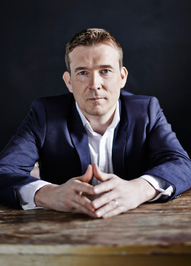Find the best price forThe Bone Clocks
David Mitchell
Paperback, Published in Jun 2015 by Sceptre
ISBN10: 0340921625 | ISBN13: 9780340921623
Page count: 613
Run away, one drowsy summer's afternoon, with Holly Sykes: wayward teenager, broken-hearted rebel and unwitting pawn in a titanic, hidden conflict.
Over six decades, the consequences of a moment's impulse unfold, drawing an ordinary woman into a world far beyond her imagining. And as life in the near future turns perilous, the pledge she made to a stranger may become the key to her family's survival . . .
Compare New Book Prices for The Bone Clocks
SEARCHING FOR PRICES...
SocialBookCo User Reviews
Sean Og Whelan on 16 Sep 2016
“Quote of the book: "To put the shoe on the other foot is the novel's chief strength"
A teenage runaway, a conniving college student, a war time correspondent, a struggling author, the eternal soul of an "Atemporal" and an elderly grandmother make up an eclectic cast of characters that come together in David Mitchell's The Bone Clocks.
Similar to his latest published work, Slade House, Mitchell once again manages to thread the unique voices of several different characters through a common overarching narrative without smothering each characters individual right to jump off the page. Mitchell himself has previously said that he prefers to write his novels in this combined novella form and it is of little wonder why he chooses so when you see how this enables him to flex his writing prowess. It also seems that his growing fanbase prefer to read the fruits of this method as his least successful work to date, The Thousand Autumns of Jacob De Zoet, apparently failed largely due to its change to the traditional first person narrative.
To focus on this novel however, it begins strongly with the tale of teenage runaway Holly Sykes who abandons her family and life in Gravesend in pursuit of a better and fairer life. This opening salvo works well as it mixes the familiar trials and tribulations of teenage angst and hormones with a dash of the mystical, all the while without disengaging the reader. While seeming familiar, it is clear that you are reading something out of the ordinary and this delicate balancing act must be commended. Mitchell does this throughout the novel, always feeding the reader with familiar tales of family weddings and pub scenes while spinning a web of mysticism and other worldliness in the background.
The highlight of the book for me came early when we are introduced to the cleverly cunning and despicable Hugo Lamb. A college student of Cambridge, Hugo survives by coldly manipulating those around him and constantly bettering himself with an impressive reading list, including such classics as The Art of War and The Magic Mountain. Reading through this part of the book I was reminded of Cathy Ames in John Steinbeck's East of Eden, who had a similar bleak outlook of the world and also saw others as stepping stones to her own personal gain. Unlike Steinbeck however, Mitchell somehow manages to keep a small part of us on this apparent villain's side.
Later on in the book, Mitchell takes an outrageous gamble by introducing us to the successful, yet struggling author Crispin Hershey. This is a character that Mitchell in interviews later referred to as ‘the monster in the mirror.' Here, the author descends into the deepest of self-parody proving that writers write best when they write what they know. Hershey lives and loathes on the busy literary festival circuit. He constantly juggles his life experiences around his head as potential novel ideas but after a strong start to his literary career, it is clear that his inspiration is all but dried up. This is probably the most enjoyable part of the novel for its self-deprecating value alone and it is incredible to see how far Mitchell takes the joke.
The real meat of the novel comes as the story builds up to the inevitable crescendo of otherworldly warfare. To finish the book with a sense of fulfilment, this section demands the reader's full attention. Up to this point, everything mythical and mystical has been spoon fed, but the introduction of a key player in the Atemporal world takes us to the heart of the action. The spectacular finale, when it does arrive, is in equal measure thrilling and disorientating. Mitchell here manages to tie up some loose ends while sprinkling a few more question marks to take us to a conclusion.
Despite all this character hopping and plot meandering, Mitchell does very well to bring everything element of his impressive creation full circle in the final pages. The novel emerges as somewhat of a coming-of-age story and it is remarkable that this sentiment comes to the fore as opposed to the supernatural themes that would overpower most story lines. Mitchell writes his concluding instalment like an encore, building another world once more and thus giving us another glimpse of his immense creative powers. Despite its 594 pages, he left this reader wanting more and that is the ultimate compliment that you can give any writer.
Would I recommend The Bone Clocks to a friend?
Yes, but I would strongly suggest reading Slade House first as a very tasty appetiser for what is to come. If you are hungry for good writing, you can still jump right into this hefty main course.”



